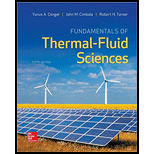
Concept explainers
The flow rate between the reservoirs and through each pipe.
Explanation of Solution
Given:
Temperature of water is
The elevation of reservoir A is 2 m.
The elevation of reservoir B is 9 m.
Length of the pipes is
Diameter of the first pipe is
Diameter of the second pipe is
Efficiency of the pump is 68%.
Power of the pump is 7 kW.
Calculation:
Refer Table A-15 “Properties of saturated water” from Appendix 1 to obtain the following properties of water:
The power required by the pump is,
Applying energy equation at points A and B at the free surface of water in reservoir A and B.
From the rate of flow through the pipes,
The Reynolds number in the first pipe is,
The Reynolds number in the second pipe is,
The friction factor is determined from the Moody chart as follows:
The head loss is,
The head loss in pipe 1 is,
The head loss in pipe 2 is,
The total flow rater between the reservoirs is,
We have 13 equations with 13 unknowns. Solving the system of simultaneous equations, we get;
Thus, the flow rate between the reservoirs, flow rate through pipe 1 and pipe 2 are
Want to see more full solutions like this?
Chapter 14 Solutions
Fundamentals of Thermal-Fluid Sciences
 Elements Of ElectromagneticsMechanical EngineeringISBN:9780190698614Author:Sadiku, Matthew N. O.Publisher:Oxford University Press
Elements Of ElectromagneticsMechanical EngineeringISBN:9780190698614Author:Sadiku, Matthew N. O.Publisher:Oxford University Press Mechanics of Materials (10th Edition)Mechanical EngineeringISBN:9780134319650Author:Russell C. HibbelerPublisher:PEARSON
Mechanics of Materials (10th Edition)Mechanical EngineeringISBN:9780134319650Author:Russell C. HibbelerPublisher:PEARSON Thermodynamics: An Engineering ApproachMechanical EngineeringISBN:9781259822674Author:Yunus A. Cengel Dr., Michael A. BolesPublisher:McGraw-Hill Education
Thermodynamics: An Engineering ApproachMechanical EngineeringISBN:9781259822674Author:Yunus A. Cengel Dr., Michael A. BolesPublisher:McGraw-Hill Education Control Systems EngineeringMechanical EngineeringISBN:9781118170519Author:Norman S. NisePublisher:WILEY
Control Systems EngineeringMechanical EngineeringISBN:9781118170519Author:Norman S. NisePublisher:WILEY Mechanics of Materials (MindTap Course List)Mechanical EngineeringISBN:9781337093347Author:Barry J. Goodno, James M. GerePublisher:Cengage Learning
Mechanics of Materials (MindTap Course List)Mechanical EngineeringISBN:9781337093347Author:Barry J. Goodno, James M. GerePublisher:Cengage Learning Engineering Mechanics: StaticsMechanical EngineeringISBN:9781118807330Author:James L. Meriam, L. G. Kraige, J. N. BoltonPublisher:WILEY
Engineering Mechanics: StaticsMechanical EngineeringISBN:9781118807330Author:James L. Meriam, L. G. Kraige, J. N. BoltonPublisher:WILEY





